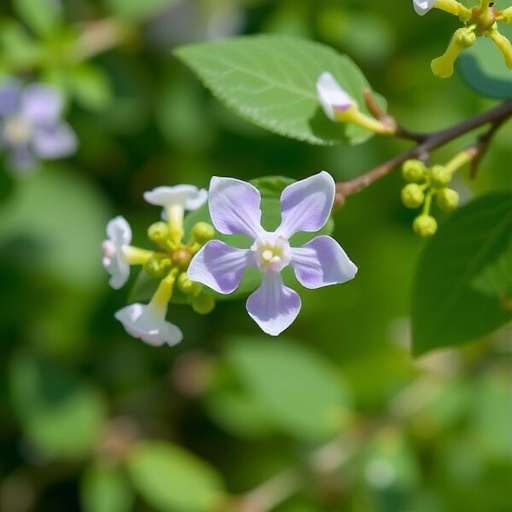In recent years, the scientific community has developed a growing interest in the intricate relationships between the morphology of pollen, karyotype dynamics, floral pigments, and scent components in various plant species. A notable study led by Qian, Zhai, and Cheng delves deep into these connections within 15 species and hybrids of Syringa L., a genus primarily known for its beautiful flowering shrubs and trees. The comprehensive research aims to unveil the remarkable ways in which these biological aspects influence the morphological classification of Syringa and its hybrids while highlighting their ecological implications.
Pollen morphology serves as a critical indicator for plant taxonomy and biodiversity. In their meticulous examination, the research team employed advanced microscopic techniques to analyze pollen grains across the selected species of Syringa. The results indicated distinct morphological variations among the different species, which could directly influence their reproductive success and ecological interactions. For example, the shapes, sizes, and surface structures of pollen grains can adapt to specific pollinator behaviors, ensuring effective reproduction in diverse environmental conditions.
In addition to pollen morphology, the study examined the karyotype of these Syringa species. Karyotype refers to the number and appearance of chromosomes within a cell, playing a pivotal role in determining a species’ evolutionary trajectory and genetic variability. The researchers uncovered notable differences in chromosome numbers and arrangements among the 15 subjects, which appear to correlate with their morphological characteristics. The implications of these findings suggest a deeper significance of karyotype diversity in the adaptation and evolution of Syringa.
Floral pigments are another critical element in understanding the complex interactions within plant species. Through chromatography and spectrophotometry, the researchers identified the range of pigments present in the flowers of various Syringa species. These findings shed light on the roles that pigments play in attracting pollinators and their potential evolution alongside scent compounds. Floral color variations, often a result of these pigments, can significantly affect a plant’s reproductive success by attracting different pollinators, which in turn can influence gene flow among populations.
Scent components of flowers are often overlooked but are vital in attracting specific pollinators. The research team conducted a comprehensive analysis of the chemical compounds responsible for floral scent in their chosen Syringa species. Using gas chromatography-mass spectrometry (GC-MS), they identified several key volatile organic compounds that contribute to the unique fragrance profiles of different Syringa species. These emissions likely evolve under selective pressures from their pollinating insects, enhancing reproductive success and ecological adaptability.
The interplay between pollen morphology, karyotype, floral pigments, and scent offers a unique lens through which to examine the evolutionary pathways of Syringa. The intricate network of relationships highlights the importance of these traits not only in taxonomy but also in the environmental adaptation of plant species. This research highlights how species classification can become a multidisciplinary endeavor, intertwining aspects of ecology, genetics, and environmental science.
One major takeaway from this study is the potential for conservation efforts focused on Syringa and similar genera. As urbanization and habitat destruction threaten these plants, understanding their morphological and genetic diversity becomes crucial for preserving their populations and the ecosystems they inhabit. By exploring the variances among various species, conservationists can develop more effective strategies to protect these plants and their pollinators, ensuring their survival amidst environmental changes.
Moreover, this research underscores the significance of interdisciplinary approaches in botanical studies. The collaboration of experts from various fields including morphology, genetics, and chemistry leads to a more comprehensive understanding of plant biology. As scientists continue to unravel these complex interactions, we can expect more cohesive conservation efforts that engage a broader range of scientific knowledge and resources.
In conclusion, the findings presented by Qian, Zhai, and Cheng illuminate essential aspects of plant biology through the lens of Syringa L. Their work not only advances our understanding of this particular genus but also sets a precedent for future botanical research that embraces complexity and synergy among biological disciplines. The future of botanical science is likely to expand further into the intricate webs of life that connect morphology, genetics, and the environment in our quest to appreciate and preserve biodiversity.
The exploration of the Syringa genus by these researchers exemplifies how nuanced scientific inquiry can drive ecological awareness and foster a deeper appreciation of the rich tapestry of life around us. As researchers continue to probe these vibrant intersections, the revelations from studies like these hold the potential to revolutionize our grasp of plant dynamics and pave the way for robust conservation practices.
The relationship between structure and function in biological organisms is critical in understanding how species adapt over time. Insights from this research into the karyotypic diversity, pollen morphology, and fragrance compounds of Syringa open a myriad of questions and pathways for researchers. Continued exploration will undoubtedly enhance our appreciation for the complexities of plant life and the fundamental principles that govern biodiversity.
In essence, the correlation presented in this pivotal study provides a stepping stone for further investigations into the evolutionary biology of flowering plants. The implications of these findings could extend beyond Syringa to inform preservation strategies for myriad plants facing the pressures of climate change and habitat loss, ensuring a sustainable coexistence with the natural world.
Subject of Research: The correlation between pollen morphology, karyotype, floral pigments, and scent components in Syringa species and hybrids.
Article Title: Correlation between pollen morphology, karyotype, floral pigments, and scent components and morphological classification of 15 species and hybrids of Syringa L.
Article References:
Qian, F., Zhai, X., Cheng, Z. et al. Correlation between pollen morphology, karyotype, floral pigments, and scent components and morphological classification of 15 species and hybrids of Syringa L.
Sci Nat 112, 15 (2025). https://doi.org/10.1007/s00114-025-01967-3
Image Credits: AI Generated
DOI: https://doi.org/10.1007/s00114-025-01967-3
Keywords: Syringa, pollen morphology, karyotype, floral pigments, scent components, hybridization, conservation, biodiversity.




